
Engine manufacturer Cummins (NYSE:CMI) announced better-than-expected revenue in Q2 CY2025, but sales fell by 1.7% year on year to $8.64 billion. Its GAAP profit of $6.43 per share was 24.7% above analysts’ consensus estimates.
Is now the time to buy Cummins? Find out by accessing our full research report, it’s free.
Cummins (CMI) Q2 CY2025 Highlights:
- Revenue: $8.64 billion vs analyst estimates of $8.36 billion (1.7% year-on-year decline, 3.4% beat)
- EPS (GAAP): $6.43 vs analyst estimates of $5.16 (24.7% beat)
- Adjusted EBITDA: $1.59 billion vs analyst estimates of $1.35 billion (18.4% margin, 17.6% beat)
- Operating Margin: 14.2%, up from 11.9% in the same quarter last year
- Free Cash Flow was $554 million, up from -$1.09 billion in the same quarter last year
- Market Capitalization: $49.81 billion
“We delivered strong second quarter results, driven by record profitability in our Power Systems and Distribution segments,” said Jennifer Rumsey, Chair and CEO.
Company Overview
With more than half of the heavy-duty truck market using its engines at one point, Cummins (NYSE:CMI) offers engines and power systems.
Revenue Growth
A company’s long-term performance is an indicator of its overall quality. Any business can experience short-term success, but top-performing ones enjoy sustained growth for years. Thankfully, Cummins’s 10.8% annualized revenue growth over the last five years was impressive. Its growth beat the average industrials company and shows its offerings resonate with customers.
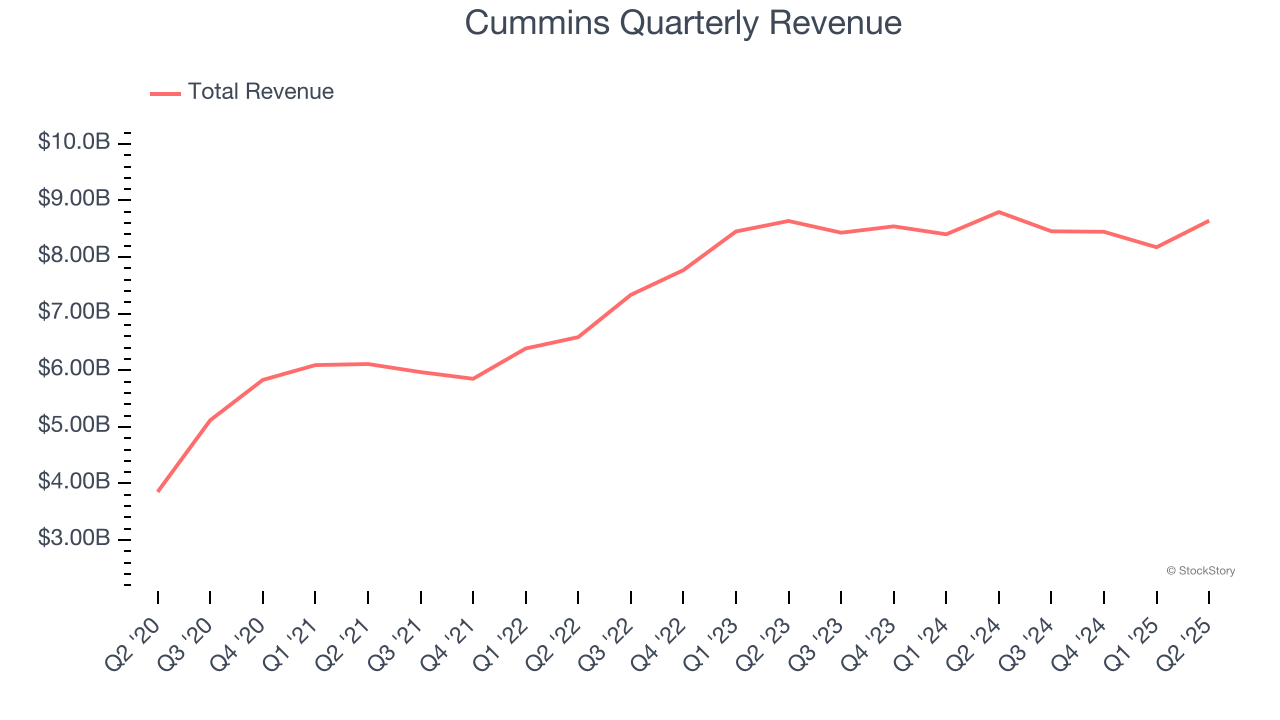
Long-term growth is the most important, but within industrials, a half-decade historical view may miss new industry trends or demand cycles. Cummins’s recent performance shows its demand has slowed significantly as its annualized revenue growth of 2.3% over the last two years was well below its five-year trend. We also note many other Heavy Transportation Equipment businesses have faced declining sales because of cyclical headwinds. While Cummins grew slower than we’d like, it did do better than its peers. 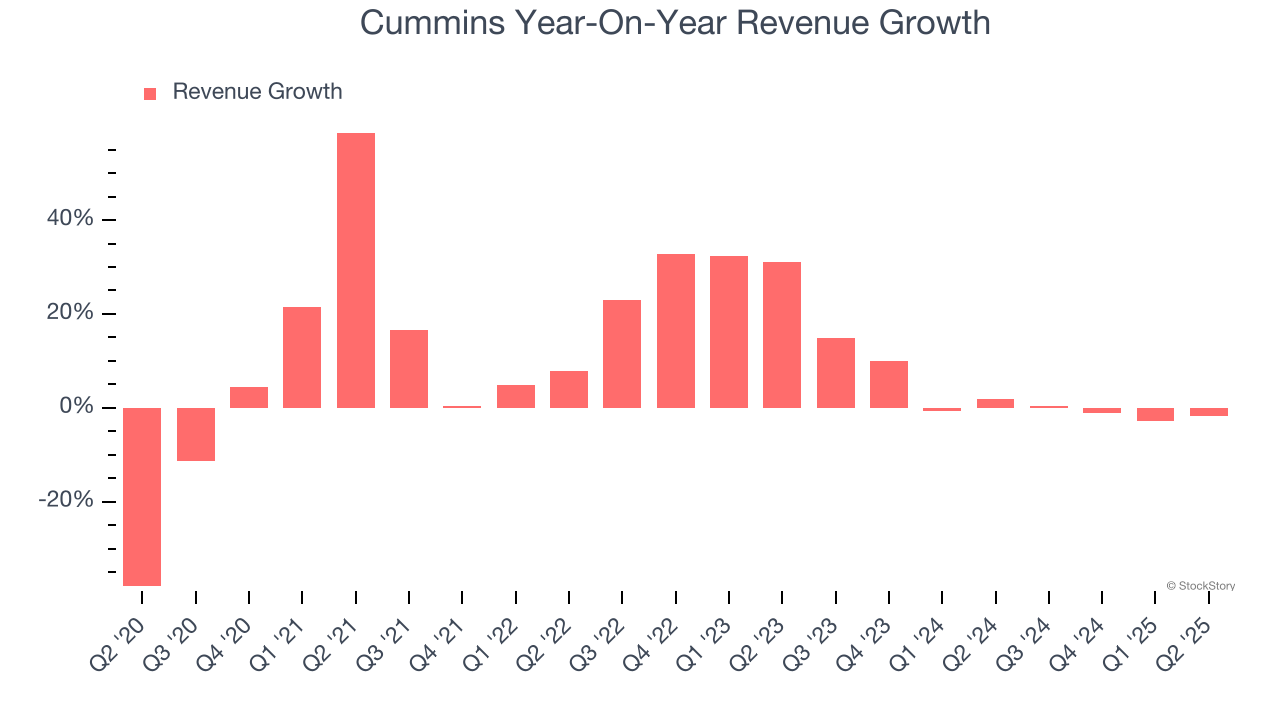
We can dig further into the company’s revenue dynamics by analyzing its most important segments, Components
and Engine
, which are 31.2% and 33.6% of revenue. Over the last two years, Cummins’s Components
revenue (axles, brakes, drivelines) averaged 7.4% year-on-year declines while its Engine
revenue (diesel and gas-powered engines) was flat. 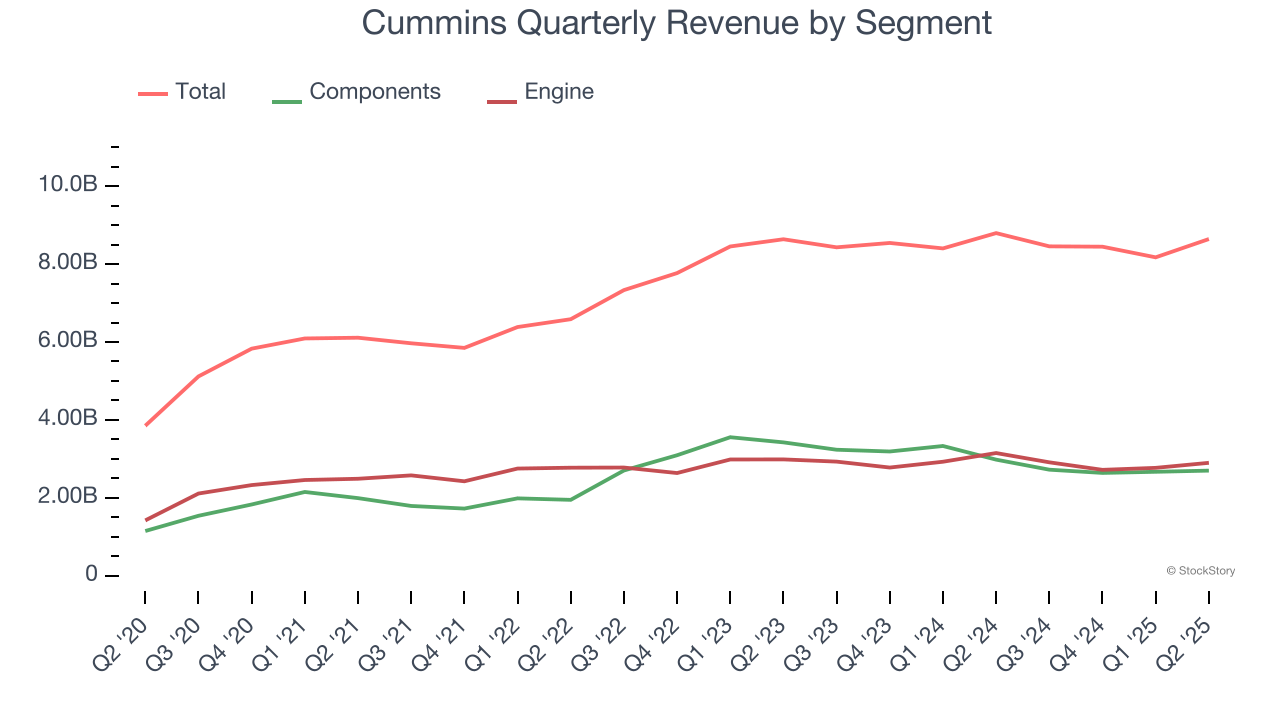
This quarter, Cummins’s revenue fell by 1.7% year on year to $8.64 billion but beat Wall Street’s estimates by 3.4%.
Looking ahead, sell-side analysts expect revenue to decline by 2.5% over the next 12 months, a deceleration versus the last two years. This projection is underwhelming and suggests its products and services will face some demand challenges.
Software is eating the world and there is virtually no industry left that has been untouched by it. That drives increasing demand for tools helping software developers do their jobs, whether it be monitoring critical cloud infrastructure, integrating audio and video functionality, or ensuring smooth content streaming. Click here to access a free report on our 3 favorite stocks to play this generational megatrend.
Operating Margin
Operating margin is an important measure of profitability as it shows the portion of revenue left after accounting for all core expenses – everything from the cost of goods sold to advertising and wages. It’s also useful for comparing profitability across companies with different levels of debt and tax rates because it excludes interest and taxes.
Cummins’s operating margin has risen over the last 12 months and averaged 10% over the last five years. Its solid profitability for an industrials business shows it’s an efficient company that manages its expenses effectively. This result was particularly impressive because of its low gross margin, which is mostly a factor of what it sells and takes huge shifts to move meaningfully. Companies have more control over their operating margins, and it’s a show of well-managed operations if they’re high when gross margins are low.
Looking at the trend in its profitability, Cummins’s operating margin might fluctuated slightly but has generally stayed the same over the last five years. This raises questions about the company’s expense base because its revenue growth should have given it leverage on its fixed costs, resulting in better economies of scale and profitability.
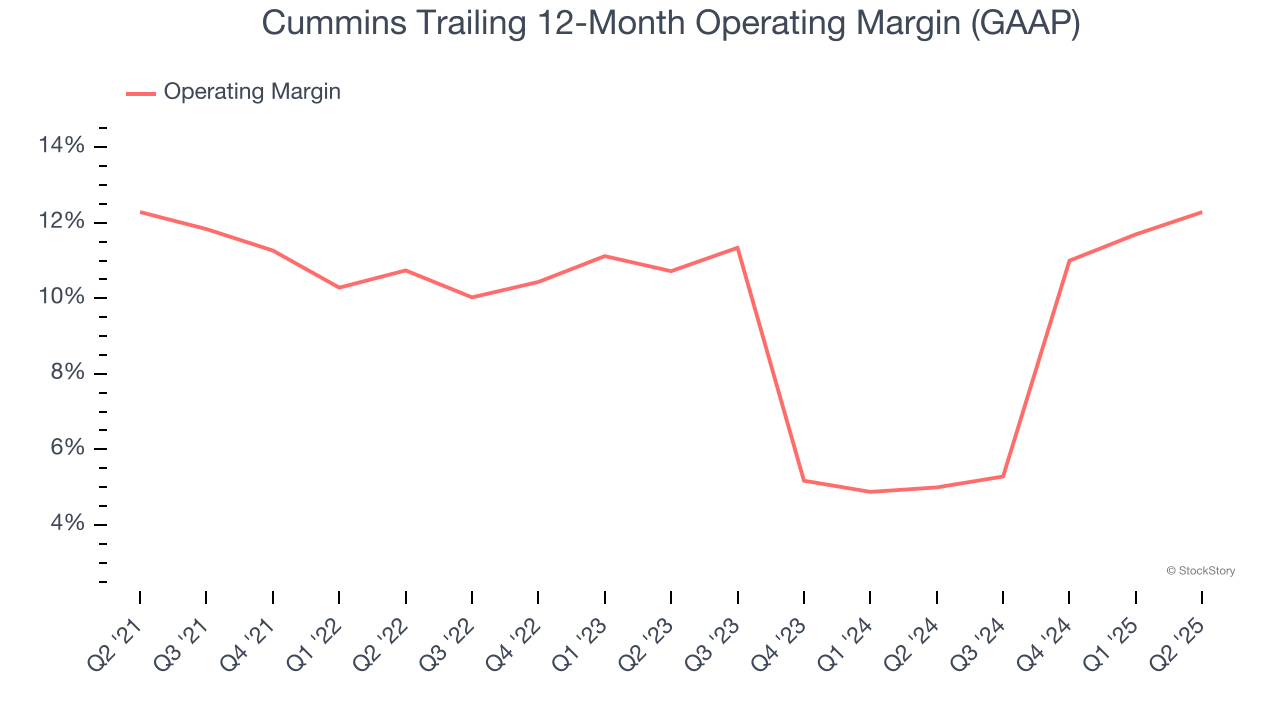
In Q2, Cummins generated an operating margin profit margin of 14.2%, up 2.3 percentage points year on year. The increase was encouraging, and because its operating margin rose more than its gross margin, we can infer it was more efficient with expenses such as marketing, R&D, and administrative overhead.
Earnings Per Share
We track the long-term change in earnings per share (EPS) for the same reason as long-term revenue growth. Compared to revenue, however, EPS highlights whether a company’s growth is profitable.
Cummins’s EPS grew at a remarkable 13.6% compounded annual growth rate over the last five years, higher than its 10.8% annualized revenue growth. This tells us the company became more profitable on a per-share basis as it expanded.
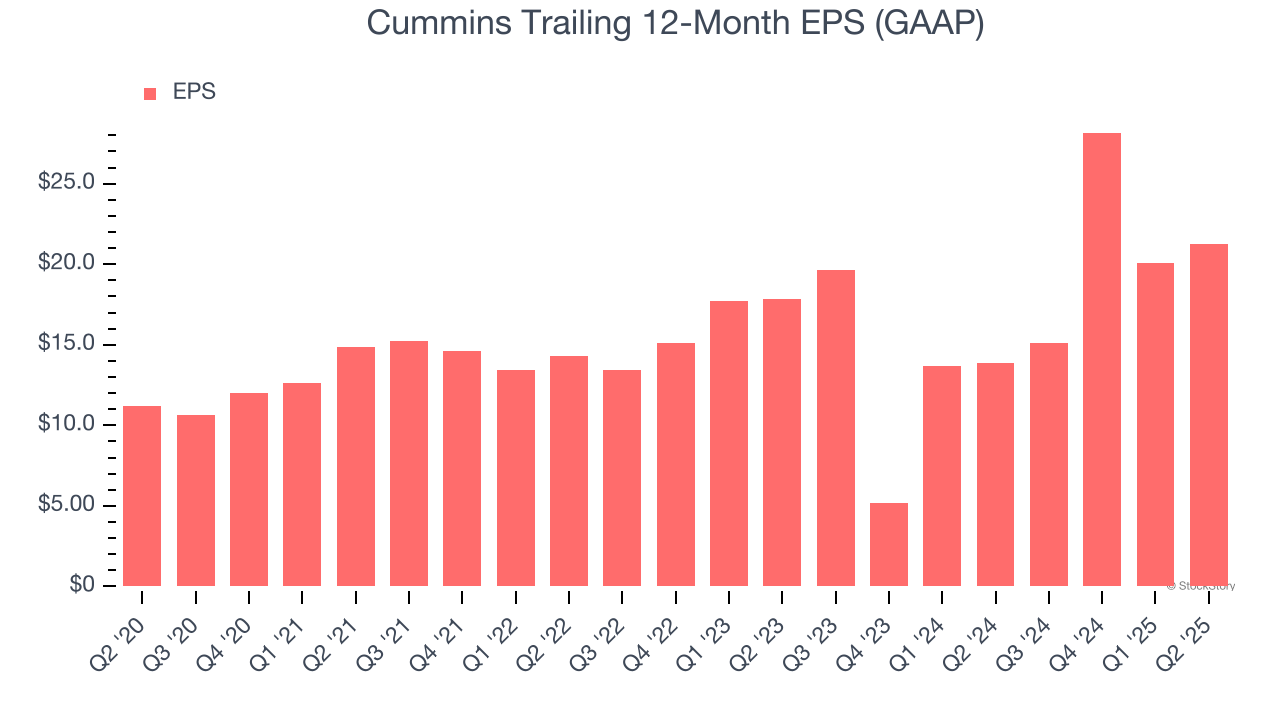
Diving into the nuances of Cummins’s earnings can give us a better understanding of its performance. A five-year view shows that Cummins has repurchased its stock, shrinking its share count by 6.4%. This tells us its EPS outperformed its revenue not because of increased operational efficiency but financial engineering, as buybacks boost per share earnings. 
Like with revenue, we analyze EPS over a shorter period to see if we are missing a change in the business.
For Cummins, its two-year annual EPS growth of 9.1% was lower than its five-year trend. We hope its growth can accelerate in the future.
In Q2, Cummins reported EPS at $6.43, up from $5.26 in the same quarter last year. This print easily cleared analysts’ estimates, and shareholders should be content with the results. Over the next 12 months, Wall Street expects Cummins’s full-year EPS of $21.27 to shrink by 5.8%.
Key Takeaways from Cummins’s Q2 Results
We were impressed by how significantly Cummins blew past analysts’ EBITDA expectations this quarter. We were also glad its Engine revenue topped Wall Street’s estimates. Zooming out, we think this quarter featured some important positives. The stock traded up 3.9% to $375.74 immediately after reporting.
Cummins may have had a good quarter, but does that mean you should invest right now? When making that decision, it’s important to consider its valuation, business qualities, as well as what has happened in the latest quarter. We cover that in our actionable full research report which you can read here, it’s free.
